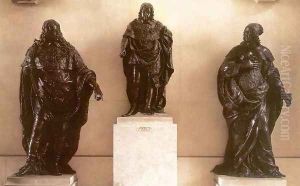Simon Guillain I Paintings
Simon Guillain I was a French sculptor born in Paris in 1581. He was part of a family of sculptors and the son of a master sculptor, also named Simon Guillain. Despite the shared name with his father, Simon Guillain I is often referred to simply as Simon Guillain, distinguishing himself with a successful career in the arts during the 17th century.
Guillain was trained under his father and possibly under other prominent sculptors of the time. He became a master in the Guild of Saint Luke, which was the guild for painters and sculptors, by 1606. Guillain's work is characterized by the Baroque style, which was dominant during his lifetime. His sculptures are known for their dynamic movement, detailed workmanship, and the emotional expressions of the figures.
In 1636, Guillain was commissioned to create a series of bronze statues for the Pont au Change in Paris. These statues depicted King Louis XIII, Queen Anne of Austria, and the Dauphin, Louis XIV. Unfortunately, these works were destroyed during the French Revolution. However, Guillain's talent and contributions to French sculpture continued to be recognized, and he received other important commissions throughout his career.
Guillain also created a notable series of terracotta reliefs that depicted the life of Saint Bruno for the Carthusian monastery in Paris. His other works include various religious sculptures, funerary monuments, and portraits in relief.
Simon Guillain I's legacy continued through his sons, who also became sculptors. He passed away in 1658 in Paris, leaving behind a body of work that contributed to the richness of French Baroque sculpture. His influence persisted through the generations, and his art remains a subject of study for those interested in the period's European sculpture.
